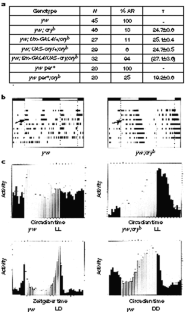A unique circadian-rhythm photoreceptor (original) (raw)
- Brief Communication
- Published: 30 March 2000
Drosophila cryptochromes
Nature volume 404, pages 456–457 (2000)Cite this article
- 2685 Accesses
- 212 Citations
- 2 Altmetric
- Metrics details
Abstract
Cryptochrome proteins are critical for circadian rhythms, but their function(s) is uncertain. Here we show that a mutation in a cryptochrome (dCRY) from the fruitfly Drosophila blocks an essential photoresponse of circadian rhythms, namely arrhythmicity under constant light conditions. We conclude that dCRY acts as a key photoreceptor for circadian rhythms and that there is probably no other comparable photoreceptor in this species.
This is a preview of subscription content, access via your institution
Access options
Subscribe to this journal
Receive 51 print issues and online access
$199.00 per year
only $3.90 per issue
Buy this article
- Purchase on SpringerLink
- Instant access to full article PDF
Prices may be subject to local taxes which are calculated during checkout
Additional access options:
Figure 1: cry b circadian rhythms free-run under intense constant light.

Similar content being viewed by others
References
- Aschoff, J. Z. Tierpsychol. 49, 225–249 (1979).
Article CAS Google Scholar - Konopka, R. J., Pittendrigh, C. & Orr, D. J. Neurogenet. 6, 1– 10 (1989).
Article CAS Google Scholar - Cashmore, A. R., Jarillo, J. A., Wu, Y. J. & Liu, D. Science 284, 760–765 ( 1999).
Article ADS CAS Google Scholar - Stanewsky, R. et al. Cell 95, 681–692 (1998).
Article CAS Google Scholar - Emery, P., So, W. V., Kaneko, M., Hall, J. C. & Rosbash, M. Cell 95, 669– 679 (1998).
Article CAS Google Scholar - Kume, K. et al. Cell 98, 193–205 (1999).
Article CAS Google Scholar - van der Horst, G. T. et al. Nature 398, 627–630 (1999).
Article ADS CAS Google Scholar - Vitaterna, M. H. et al. Proc. Natl Acad. Sci. USA 96, 12114 –12119 (1999).
Article ADS CAS Google Scholar - Ohata, K., Nishiyama, H. & Tsukahara, Y. in Biological Clocks: Mechanisms and Applications (ed. Touitou, Y.) 167–170 (Elsevier, Amsterdam, 1999).
Google Scholar - Ewer, J., Frisch, B., Hamblen-Coyle, M. J., Rosbash, M. & Hall, J. C. J. Neurosci. 12, 3321–3349 (1992).
Article CAS Google Scholar
Author information
Authors and Affiliations
- Department of Biology, NSF Center for Biological Timing, Brandeis University, Waltham, 02454, Massachusetts, USA
Patrick Emery, Jeffrey C. Hall & Michael Rosbash - Howard Hughes Medical Institute, Brandeis University, Waltham, 02454, Massachusetts, USA
Michael Rosbash - Zoologisches Institut, Universität Regensburg, Regensburg, D93040, Germany
Ralf Stanewsky
Authors
- Patrick Emery
You can also search for this author inPubMed Google Scholar - Ralf Stanewsky
You can also search for this author inPubMed Google Scholar - Jeffrey C. Hall
You can also search for this author inPubMed Google Scholar - Michael Rosbash
You can also search for this author inPubMed Google Scholar
Corresponding author
Correspondence toMichael Rosbash.
Rights and permissions
About this article
Cite this article
Emery, P., Stanewsky, R., Hall, J. et al. A unique circadian-rhythm photoreceptor.Nature 404, 456–457 (2000). https://doi.org/10.1038/35006558
- Issue Date: 30 March 2000
- DOI: https://doi.org/10.1038/35006558